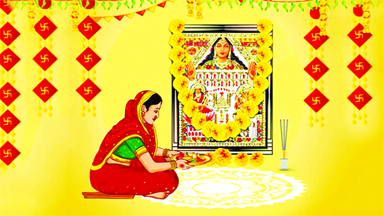
Ahoi Ashtami is an auspicious festivals of Hindus. This is widely celebrated in North India by Hindu women. The fast is observed for the good health and longevity of children. Ahoi Ashtami is also known as Ahoi Aathe. The festival of Ahoi Ashtami is celebrated on Ashtami Tithior eighth day of Krishna Paksha in the month of Kartik.
This year, Ahoi Athe fast will be observed on November 5, 2023.
Just like Karwa Chauth the celebrations of Ahoi Ashtami is very widespread in the whole of northern India. This day is dedicated to worshipping Goddess Ahoi or Ahoi Mata. Ahoi ashtami vrat is observed only by Mothers, as the vrat is kept for the long life and well being of their children and also to be blessed with more children.
Rituals during Ahoi Ashtami
On Ahoi Ashtami, the mother of boy observes a strict fast all through the day for their child’s well-being. They spend the day even without drinking a drop of water. The fast is broken after sighting the stars, during twilight. In some places, the observer of the Ahoi Ashtami fast break their fast after sighting the moon, however it might be difficult as the moon rises late on the Ahoi Ashtami night.
Women get up early and take a bath. Following this they take a ‘sankalp’ that is a pledge to keep the fast for the whole day for their children’s well-being. The preparations for the puja are done before the sunset.
Women draw the image of Ahoi Mata on a wall. The image drawn should have ‘Ashtha Koshthak’ or eight corners. Along with other images, the picture of ‘Sei’ (hedgehog with its children) is drawn close to Goddess Ahoi. If the image cannot be drawn then the wallpaper of Ahoi Ashtami can also be used. The image also depicts the seven sons with the daughter-in-laws as mentioned in the Ahoi Ashtami katha.
The place of worship is cleaned and an ‘Alpana’ is drawn. An earthen pot known as ‘karwa’ is filled with water and covered with a lid and kept near the place of worship. The nozzle of this karwa is blocked with a special grass known as ‘Sarai Seenka’. This shoot of grass is also offered to Ahoi Mata during the puja rituals. The actual puja of Ahoi Ashtami is performed during sandhya time, that is, just after sunset. All the women in the family get together for the puja. After the rituals the women listen to the Ahoi Mata vrat katha. In some communities the devotees use Ahoi made from silver. This silver form is known as ‘Syau’ and is worshipped with milk, roli and akshata during the puja. After the puja, this ‘Syau’ is woven in a thread with two silver pearls and worn by women around their neck.
Special food offerings are prepared that includes puri, halwa and pua. 8 of all these are offered to the Goddess and then given to some elderly lady or even a Brahmin. The puja is terminated by performing the ‘Ahoi Mata aarti’ at the end.
Significance of Ahoi Ashtami
Ahoi Ashtami fast is undertaken by mothers of boys for the long life and happiness of their sons. They worship Goddess Ahoi on this day with full devotion and fervour. On this day women observe a fast for their sons. The time for sighting the stars and moonrise can be seen in the Ahoi Ashtami Puja timings in the Hindu panchang.
It is believed that women who face miscarriage or have problems in conceiving should perform the Ahoi Ashtami puja and vrat to get blessed with a baby boy. For this reason, it is also known as ‘Krishnashtami’. This day is therefore significant for childless couples. On this occasion, couples take a holy dip in the ‘Radha Kunda’ at Mathura. Devotees from all over the country come and throng the place during this time.
Ahoi Ashtami Vrat Katha
According to the story of Ahoi Ashtami, long time ago, a moneylender lived in a city. He had seven sons. Once, when only seven days were left for Diwali, the family was engaged in cleaning the house. For renovation of their house, the moneylender’s wife went to collect mud from an open pit mine near the river. Unaware that a hedgehog has build its den in the mine, the moneylender’s wife started digging for mud. While doing so, her hoe hit a hedgehog cub killing it instantly. Seeing this, the moneylender’s wife felt very sad. Heartbroken she returned to her home. A few days after due to the curse of the hedeghog mother, the woman’s eldest son died, then the second son died, and likewise the third child was no more and in one year all their seven sons died.
Due to the death of all her children, the woman started living very sad. One day, while crying, she told her sad story to one of her elderly neighbours and confessed that she did not commit the sin on purpose and that the cub was killed unknowingly and that it was after the incident her seven sons died. On hearing this, the old lady comforted her and said that half of her sin has been redeemed by her repentance. The woman also suggested that, on the day of Mata Ahoi Ashtami, with recourse to Goddess Bhagwati, by drawing a picture of hedgehog and its cubs, worshiping them and apologizing for her act, she will be benefited. The woman also said that doing so, by the grace of God, all her sins will be cleansed. The moneylender’s wife obeyed the old woman and worshiped Mother Ahoi. Fasting on the eighth day of the Krishna Paksha of Kartik month, she started doing this regularly every year and with time, she got seven sons. It is since then the tradition of Ahoi Ashtami vrat has started.
Ahoi Mata Puja
The best time to perform Puja is during Sandhya (evening) time just after sunset. During Puja Ahoi Mata is worshipped with all rituals.
Usually women perform Ahoi Ashtami Puja along with the other female members of the family. During Puja women narrate the story of Ahoi Mata. There are several versions of Ahoi Ashtami legend but most of them describe how female devotee of Ahoi Mata got blessed by seven sons even after getting cursed for accidently killing the offsprings of Sei. Sei is also worshipped along with Ahoi Mata and seven grass shoots along with Halwa is offered to Sei.
In some communities, for the occasion of Ahoi Ashtami, Ahoi of silver is also made. Silver Ahoi is known as Syau and worshipped with Akshata, Roli and the milk during the Puja. Later it is worn in the neck as a pendant with the help of a thread along with two silver pearls.
Aarti of Ahoi Ashtami is performed at the end of the Puja.
Stars or Moon worship
Women either give Argha to the stars or the moon depending on the family tradition before breaking the fast. The time when the stars get visible in the sky and the time of moonrise on Ahoi Ashtami can be checked at Ahoi Ashtami Puja Timings.
Both Karwa and Kalash are used for giving Argha to the stars or the moon after the Puja. The water of big Kalash is used during the morning bath of Roop Chaudas which is also known as Narak Chaturdashi.
Association with Krishnashtami
Women who have difficulties in conceiving, have miscarriage or don’t have a boy child also perform Puja on the day of Ahoi Ashtami.
In this context, the day of Ahoi Ashtami is known as Krishnashtami. This day is very significant for those couples who don’t have any children. On the very same day couples take dip in the Radha Kunda at Mathura, perform Puja and make offering of the Kushmanda. Devotees from far-flung places throng to Radha Kunda to take a holy dip in the sacred pond during Arunodaya i.e. just before the sunrise.





Be the first to comment